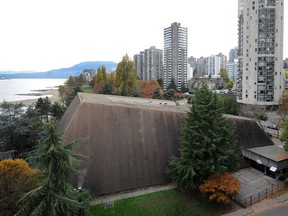Assuming our provincial and federal politicians are committed to developing more housing, they must reform the way infrastructure dollars are distributed to municipalities.

Article content
Our provincial government tells cities to build more housing, but discourages those that do.
Advertisement 2
Article content
After a snowfall, parents and staff inside New Westminster’s Queen’s Park Arenex reported hearing “cracking noises” in the roof. On any given day, dozens of children and their parents participated in sports and recreation programs at this facility. Several hours after the doors closed and the kids, parents and staff went home, the aging roof collapsed and the building imploded.
In March, just after Vancouver’s popular Aquatic Center had closed for the day, a large section of the building’s facade came crumbling to the ground. The center was built in 1974 at Sunset Beach, next to the Burrard Street Bridge.
While both incidents are very different in nature, they help to illustrate the growing infrastructure deficit facing many older, high-density communities in our region. Thankfully, in both cases the facilities were empty, thus avoiding what would have become a national tragedy.
advertisement 3
Article content
So how did we get to this point where cities like New Westminster and Vancouver, two of the most densely populated of our region, are living with archaic, crumbling public infrastructure that is in dire need of replacement?
A recent report released by the City of Vancouver regarding the state of their public facilities sheds some light on this issue.
In response to the report, Vancouver City Council. Sarah Kirby-Young told CKNW radio, “We have an infrastructure deficit in the City of Vancouver. We’re currently spending $300 million a year in terms of renewal for infrastructure, but staff have identified the need is $800 million, so we have a $500-million gap.”
A lot has been written lately about Housing Minister David Eby’s frustration with cities. The ministers cites bureaucratic delays, red tape and a litany of other reasons why cities are dragging their feet when it comes to approving new housing.
advertisement 4
Article content
Accommodating growth through increased density is inevitable in a region as popular as ours. Lost in the discussion is the important need to get buy-in from the people who live here. Many of those people equate higher density with crowded community centers, a lack of parks, schools, and daycare spaces. The crumbling infrastructure at the Arenex and Aquatic Center reinforces the narrative that there are no upsides to growth and higher density.
Assuming our provincial and federal politicians are committed to developing more housing, they must reform the way infrastructure dollars are distributed to municipalities.
A first step would be to ensure cities that have already accepted higher density, or have a clear plan to accommodate growth, are moved to the front of the line.
advertisement 5
Article content
This policy reform doesn’t require new legislation, nor does it require further study. It simply requires the political will to invest in communities that have already embraced densification or have concrete plans to do so.
Then we can finally begin to change the narrative that “all we get is growth and nothing to show for it.” Providing a direct correlation between growth and new federal and provincial investments in libraries, pools, parks, skating rinks and community centers is crucial if governments hope to be successful in building more affordable housing.
Unfortunately, a recent decision doesn’t appear to support the theory that the BC government is interested in providing a real “carrot” to communities that have embraced density.
advertisement 6
Article content
The Ministry of Education advised the New Westminster School Board that it was not going to receive any new funding this year for major capital projects. What message does that send to other cities who are being called out by Victoria and Ottawa for not fast-tracking new developments and growth?
Regardless of what side of the density debate you fall on, most would agree that growth must be accompanied by new investments in public amenities. The development of affordable housing, on its own, can’t be the only benefit for neighborhoods grappling with growth.
Our governments need to provide the right “carrots” for cities that have already done the heavy lifting when it comes to densification. Otherwise, it will no doubt take a “stick” to get the others in line.
Daniel Fontaine is a resident of New Westminster and served as chief of staff to former Vancouver Mayor Sam Sullivan.
Letters to the editor should be sent to [email protected]. The editorial pages editor is Hardip Johal, who can be reached at [email protected].
CLICK HERE to report a typo.
Is there more to this story? We’d like to hear from you about this or any other stories you think we should know about. E-mail [email protected].